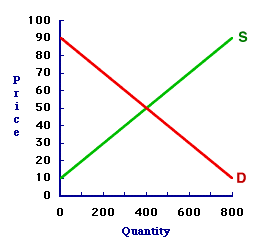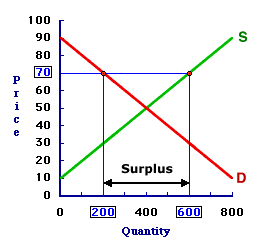
|
|
INCREASING OPPORTUNITY COST: The proposition that opportunity cost, the value of foregone production, increases as more of a good is produced. This 'law' is most important to the slope of the production possibilities curve. It generates the convex shape of the curve, making the curve flat at the top and steep at the bottom.
Visit the GLOSS*arama
|
|


|

|
                           SURPLUS: A condition in the market in which the quantity demanded is less than the quantity supplied at the existing price. Because sellers are unable to sell as much of the good as they want, a surplus generally causes a decrease in the market price, which then acts to restore equilibrium. A surplus, which also goes by the terms excess supply and buyers' market, is one of two basic states of disequilibrium for the market. The other is shortage. A surplus exists in a market when the current market price is greater than the equilibrium price. Acting on the law of demand and law of supply, the relatively high price generates a smaller quantity demanded and a larger quantity supplied than needed for equilibrium. In other words, when the price is relatively high, sellers want to sell a lot more of the good than buyers want to buy.A market surplus can be caused by a change in any of the demand determinants or supply determinants. A decrease in demand or an increase in supply does the job. A surplus also can be imposed on a market through government intervention, especially by establishing a price floor above the equilibrium price. Working the Market| The Surplus |  |
A surplus can be illustrated using the market for 8-track tapes displayed in this exhibit. This graph was generated after long hours attending the 88th Annual Trackmania 8-Track Tape Collectors Convention at the Shady Valley Exposition Center.The equilibrium, found at the intersection of the negatively-sloped demand curve and positively-sloped supply curve is at a price of 50 cents and a quantity of 400 tapes. Equilibrium, however, is not the primary point of interest. The interest lies in disequilibrium and surplus. A surplus emerges at any price above the equilibrium price of 50 cents. A prime candidate to generate a surplus is a price of 70 cents. Click the [Surplus] button to illustrate the resulting surplus. - Quantity Supplied: At 70 cents, the quantity supplied is 600 tapes. Because the price is relatively high, sellers are guided by the law of supply and are willing and able to offer a great deal of the good for sale.
- Quantity Demanded: However, at the same 70 cent price, the quantity demanded is 200 tapes. At this relatively high price, buyers act according to the law of demand and are willing and able to buy a small amount of the good.
- The Surplus: The end result is that the quantity supplied exceeds the quantity demanded by 400 tapes. As such, the surplus at 70 cents is 400 tapes. Of course, a different price generates a different surplus.
Then What?| Eliminating the Surplus |  |
A market reacts in a specific manner in response to a surplus. Although buyers are able to buy as much of the good as they want at the going market price, sellers are not able to sell as much of the good as they want. In this example, buyers are able to buy all 200 tapes they want. Sellers, however, are only able to sell 200 of the 600 tapes they want. The sellers come up short by 400 tapes.Because sellers are not satisfied with this surplus, because they cannot sell all of the tapes that they are willing and able to sell at 70 cents each, they are motivated to offer a lower price, to induce buyers to purchase a larger quantity. Click the [Price Fall] button to illustrate what occurs. What happens as this price falls? - Increase in Quantity Demanded: According to the law of demand, a lower price induces an increase in the quantity demanded. This is just the sort of thing that the sellers hope happens when they charge a lower price. They want a larger quantity demanded.
- Decrease in Quantity Supplied: However, according to the law of supply, a lower price also induces a decrease in the quantity supplied. Sellers who supply a large quantity at the 70 cent price are inclined to reduce their quantity supplied as the price falls.
- No More Surplus: The increase in the quantity demanded and the decrease in the quantity supplied both act to eliminate the surplus. Best of all, as long as any surplus exists, the price continues to fall, and the surplus shrinks. The price stops falling ONLY when it reaches 50 cents, which is the equilibrium price, the price that generates the same quantity demanded as supplied. It is the price that does not have a surplus.

Recommended Citation:SURPLUS, AmosWEB Encyclonomic WEB*pedia, http://www.AmosWEB.com, AmosWEB LLC, 2000-2025. [Accessed: July 18, 2025].
Check Out These Related Terms... | | | | | | | | | | |
Or For A Little Background... | | | | | | | |
And For Further Study... | | | | | | | |
Search Again?
Back to the WEB*pedia
|



|

|
BROWN PRAGMATOX
[What's This?]
Today, you are likely to spend a great deal of time browsing through a long list of dot com websites seeking to buy either a case of blank recordable DVDs or a pair of red goulashes with shiny buckles. Be on the lookout for mail order catalogs with hidden messages.
Your Complete Scope
This isn't me! What am I?
|

|
|
The New York Stock Exchange was established by a group of investors in New York City in 1817 under a buttonwood tree at the end of a little road named Wall Street.
|

|
|
"A winner is someone who recognizes his God-given talents, works his tail off to develop them into skills, and uses those skills to accomplish his goals. " -- Larry Bird, basketball player
|

|
ISMA
International Securities Market Association
|

|
|
Tell us what you think about AmosWEB. Like what you see? Have suggestions for improvements? Let us know. Click the User Feedback link.
User Feedback
|


|


